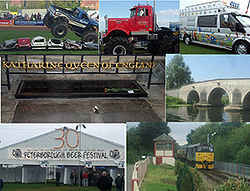Difference between revisions of "Peterborough"
| Line 5: | Line 5: | ||
The area is flat and low lying, with the Fens lying to the east of the city. Human settlement in the area dates back to before the Bronze Age (2300-600 BC), and evidence of this can be seen at the Flag Fen Archaeological Site, in the Fengate area of the city. | The area is flat and low lying, with the Fens lying to the east of the city. Human settlement in the area dates back to before the Bronze Age (2300-600 BC), and evidence of this can be seen at the Flag Fen Archaeological Site, in the Fengate area of the city. | ||
| − | |||
| style="width:250px" align="right"| __TOC__ | | style="width:250px" align="right"| __TOC__ | ||
| Line 37: | Line 36: | ||
[[Image:PETERBOROUGH.jpg|align right|250px|thumb|Nene Valley Railway, the River Nene, Beerfest and Truckfest, Katherine of Aragons Tomb. Submitted by: Yummy-mummy-of-2]] | [[Image:PETERBOROUGH.jpg|align right|250px|thumb|Nene Valley Railway, the River Nene, Beerfest and Truckfest, Katherine of Aragons Tomb. Submitted by: Yummy-mummy-of-2]] | ||
| − | <br><br> | + | <br><br><br> |
Revision as of 15:39, 23 June 2008
| The Cathedral city of Peterborough is situated on the River Nene in the heart of Cambridgeshire, 80 miles north of London. Whilst it is self-governing, it forms part of the county of Cambridgeshire for ceremonial purposes.
|
Contents |
| The city's railway station is on the East Coast Main Line, which terminates at London in the south and at Edinburgh in the north. It also connects with the stations of the east coast. It was the coming of the railways in the 19th century which led to the rapid increase in the population, which resulted in the market town becoming an industrial centre, particularly in brickmaking, due to the vast supply of local clay deposits. There was further growth in the 1960s, when it was designated as a 'New Town'.
|
Resources
Places of Interest
Back to Cambridgeshire
